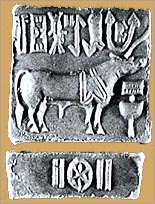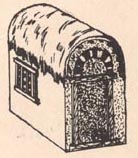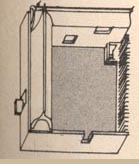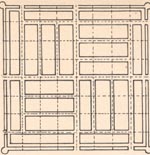Apr 18, 2025
Apr 18, 2025
The End of Harappa
 The nomads that streamed in from the Northwest towards the middle of the second millennium B.C. overwhelmed the indigenous people of the subcontinent with their superior military technology. The Indus Valley Civilization, weakened from generations of fighting the river floods, constantly rebuilding their cities, lacked the moral will to put up much resistance. In short order the magnificent cities were emptied of all population, and the Dasyus, as the Aryan invaders contemptuously called them, either were co-opted into the lowest rung of the new society, or migrated further south into peninsular India.
The nomads that streamed in from the Northwest towards the middle of the second millennium B.C. overwhelmed the indigenous people of the subcontinent with their superior military technology. The Indus Valley Civilization, weakened from generations of fighting the river floods, constantly rebuilding their cities, lacked the moral will to put up much resistance. In short order the magnificent cities were emptied of all population, and the Dasyus, as the Aryan invaders contemptuously called them, either were co-opted into the lowest rung of the new society, or migrated further south into peninsular India.
Curiously, the Aryans did not settle into the well-planned cities of the Harappan culture, and instead preferred to clear forests around the riverbanks of the Gangetic plain and settle in small villages. This could be due to the inherent dislike of a pastoral people to settle in one place for very long, and thus their innate suspicion of any hint of permanence. Or of course, it could be the sheer alien value of the architecture that they found, and they preferred to stick with the tried and tested.
Blueprint for the Future
No architectural examples of this period are surviving. The Aryans built no colossal monuments. So what is the importance of this period? It was early Aryan architectural forms that were translated into the architecture of India for thousands of years. The caves of Ajanta and Ellora, much of Buddhist architecture, were directly influenced by the simple village structures of the Aryan villages.
But if there are no remaining specimens, what are the sources through which we glean knowledge about the architecture? Considerable information is given in the Vedas. These ancient texts were composed by the Aryan seers and handed down through generations orally. The great epics, the Mahabharata and the Ramayana, vividly picture village and town life during Aryavrata, or the Aryan age. In addition, carvings on the Stupas at Barhut and Sanchi, which depict Aryan village life vividly.
 Upon coming to India, the settlers gave up their totally nomadic existence and became part-agriculturalists. This provided the impetus to build villages, the basic unit of which was the hut. For building material, the abundant forest provided ample raw stock. The Aryan hut, in its most basic shape, was circular in plan, with a thatched roof over a bamboo network of ribs. This was later elongated to become rectangular in plan, with roofing of bamboo as well, only this time curved in the shape of a barrel. Clusters of these huts formed a courtyard, much like huts in Indian villages even today. The better-off citizens roofed them with planks of wood or tiles, and used unbaked bricks for the walls. To maintain the barrel shape of the roof, a thong or string, perhaps of animal hide, was stretched across the end of the bamboo.
Upon coming to India, the settlers gave up their totally nomadic existence and became part-agriculturalists. This provided the impetus to build villages, the basic unit of which was the hut. For building material, the abundant forest provided ample raw stock. The Aryan hut, in its most basic shape, was circular in plan, with a thatched roof over a bamboo network of ribs. This was later elongated to become rectangular in plan, with roofing of bamboo as well, only this time curved in the shape of a barrel. Clusters of these huts formed a courtyard, much like huts in Indian villages even today. The better-off citizens roofed them with planks of wood or tiles, and used unbaked bricks for the walls. To maintain the barrel shape of the roof, a thong or string, perhaps of animal hide, was stretched across the end of the bamboo.
The Three Stages of Vedic Houses
| Stage 1 | Stage 2 | Stage 3 |
 |
 |
 |
For protection against wild animals, a palisade fence of wood and bamboo surrounded the whole settlement. This fence was made of upright posts of bamboo with horizontal members threaded into holes in posts. At one point, the fence was extended forward to form a sort of gate. These forms - the barrel vaulted roof, the tie-cord, and the palisade fence and railing, formed important motifs for future Indian Architecture. In fact, huts in modern Orissa, one of the poorest Indian states, are still carrying traces of this influence, with symbolism dating back to Vedic times.
City-states and Timber Construction
 With the conversion of the early Vedic people into agriculturalists, a growing rivalry for precious fertile land was inevitable. Groups of small villages banded together, and small 'cities' began to take shape. A palisade wall inevitably protected these and the buildings within were also made almost entirely of wood. The Vedic carpenters developed skill in timber construction of a very high standard. It is not surprising, therefore, that in later ages timber construction techniques were employed even though the material of construction was radically different - i.e. stone.
With the conversion of the early Vedic people into agriculturalists, a growing rivalry for precious fertile land was inevitable. Groups of small villages banded together, and small 'cities' began to take shape. A palisade wall inevitably protected these and the buildings within were also made almost entirely of wood. The Vedic carpenters developed skill in timber construction of a very high standard. It is not surprising, therefore, that in later ages timber construction techniques were employed even though the material of construction was radically different - i.e. stone.
In general, the cities of the Vedic period were rectangular in plan and divided into four quarters by two main thoroughfares intersecting at right angles, each leading to a city gate. One of these quarters contained the citadel and another housed the residential area. A third quarter was reserved for the merchants, and the last for tradesmen who could display their wares.
From these modest beginnings, early Hindu architecture gradually metamorphosed into the magnificent Buddhist stupas and the rock-cut caves at Ajanta. How these masterpieces of world architecture came about from a background of nomads, is the subject of our next article.
04-Jan-2001
More by : Ashish Nangia

|
Interested to know more about vedic architecture and its construction techniques. The lifestyle during this era, the beliefs and much more about it. |

|
Aryan Invasion is definitely not a myth. Till date you can see wide cultural differences between north and southern Indians. Languages which are totally totally different and so are the food habits. And many of the European languages bear remarkable similarity to Sanskrit which is the so called language of the 'Aryans'. All the existing evidence points to Aryan invasion/ or mass migration. |

|
Danny, You wish Ashish to discard his historical beliefs and replace them with yours. But you provide no proof whatsoever that your claims have any truth. If there was never an Aryan invasion, what is your evidence? None provided by you. If Aryan means noble or teacher, what is the source of your claim? None provided. Where is the proof that the Saraswati river dried up 2000 BC? None provided. This is true of every hysterical-illiterate claim that you make about ancient India. By contrast, most of what we have learnt from the British about our own past is backed with evidence. And when they didn't have the evidence, they said so. In short, it is you who is embarrassing India. |

|
thermoluminance technic have conferm that destructed parts of vedic cites like related to mahabharat e.g hastinapur & dwrka goes back to 2800bc so why we stil belive in aryan invention theory.i think we indian have to reserch on our culture in our way . |

|
Do you have any reliable references or sources for this comment? Because I have for my work. In particular, if you have any documents or links to corroborate your viewpoint, please share. Also, this is a public forum and I would not use language that is embarrassing India as well. |

|
This is exactly the proof of a country so damaged by British Lies they are continuing to teach the same crap the british led us to beleive about our own history, when will you indians realise the Royal Asiatic society lie to you about a so called aryan invasion! there never was and the word Aryan means noble or teacher. The vedas are a literature developed over thousands of years and not brought with nomads, and then why do these nomads from europe never once refer to a european area or homeland and why was teh river saraswati mentioned numerous times and which dried up 2000bc! blows your timescale right out of the water! also why does underwater cities have the same cultural planning and tehy were last on land 9000 years ago! Ashish you really need to go back to school and research not repeat crap told to you! you are now embarassing india! |